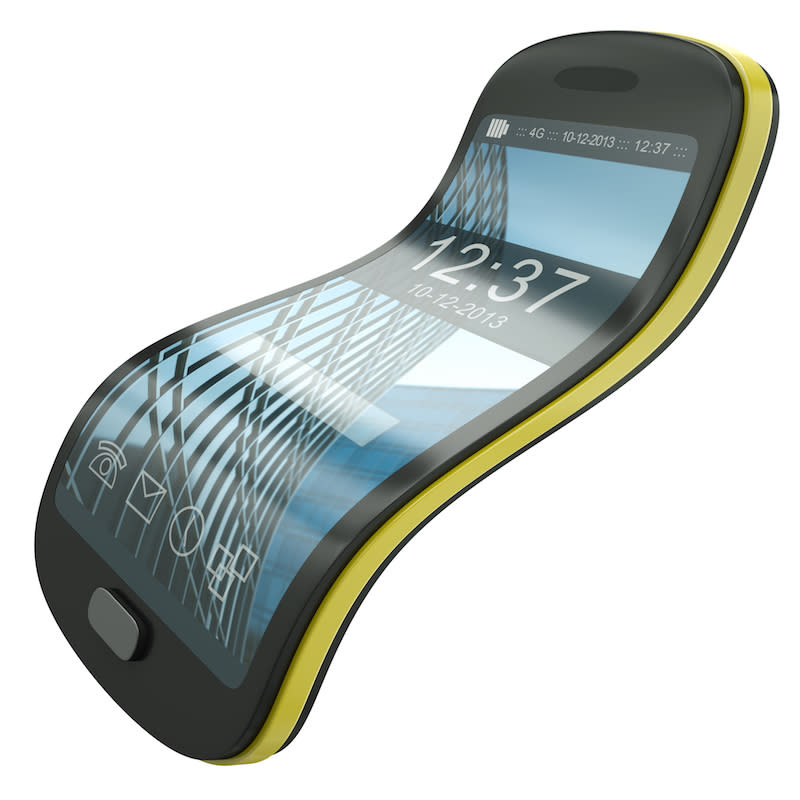These futuristic interfaces will change how you use your smartphone
Smartphones have become more advanced over the past decade, significantly changing the way users interact with them. In addition to offering basic functions like wireless calling and taking pictures, smartphones now serve as pocket-sized computers that allow people to bank online, video chat with friends and find the nearest store, all from the convenience of their fingertips. The integration of a touchscreen -- allowing manufacturers to get rid of the physical dialpad in favor of more screen area -- was pivotal in ushering in these new applications. And as the touchscreen has become the dominant smartphone interface, tapping, pinching, swiping and scrolling quickly have become the norm for how we navigate them -- but thanks to new breakthrough designs all of that is about to change.
From flexible displays that will let you slap your smartphone onto your wrist, to touchscreens with tactile 3D surfaces that pop out on-demand, tomorrow's smartphone interfaces are as varied as they are unique. We teamed up with Honor 8 to explore some of the most futuristic interface technologies to show how they'll redefine how we interact with our phones.
Mind-bending possibilities

If you thought phones were going to maintain their rectangle shape, think again. Improvements in graphene technology will soon allow manufacturers to make smartphones that can adapt their shape for different uses. Firms, including the British FlexEnable, are taking advantage of graphene's lightness and durability to make smartphone prototypes that can be collapsed into a bracelet, solving the problem of where to stow your device when using it hands-free. Other hardware that uses bendable graphene includes flexible screens that can be rolled out on-demand; expect to see these tucked into watches, helmets and even pens.
Hello, holo-phone

If you've ever tried to show photos or videos on your phone to other people, you're aware of the difficulty of pointing things out without your fingers getting in the way. Thanks to emerging holographic technology, you'll soon be able to channel your inner-"Star Wars" nerd and project your media as 3D holograms that can be viewed from any angle. Similar to the technology found in the Holus tabletop, holographic phones could integrate a glass prism to project otherwise flat content as a 3D hologram, allowing users to see the projects above the phone without additional gear like 3D glasses. With the addition of motion controls, the utility of this technology could allow engineers to interact with a set of blueprints, use Google Earth 3D to explore the planet, or even have lifelike face-to-face conversations over holographic video chat. While holo-phones are still in the pre-research phase of development, more prototypes are forthcoming, with HoloFlex, a project out of Queen's University, showing the most promise so far.
Raising the bar

One of the tradeoffs of switching the control interface of phones from a physical keypad to a touchscreen was the loss of a tactile input mechanism, leaving touch typists and those with low vision at the whims of a finicky speech-to-text system.
But what if we didn't have to rely on the archetype of the flat, 2D touchscreen to control our phones?
That's the thinking behind augmenting touchscreens with microfluidics -- liquids that can be manipulated to change shape on command -- which would essentially create a 3D surface on which to interact with our phones. The practical uses include on-demand Braille keyboards, and better control for touch-sensitive applications like typing and gaming. Though we might still be a few years away from reaping the benefits of microfluidics, Tactus Technology, a Bay Area startup, has shown several working prototypes using the technology (pictured above).
Beyond touchscreens

In the not-too-distant future, control of your smartphone may move entirely away from the device and onto your body. While you're certainly aware of smartwatches, did you know there are removable tattoos developed by MIT that let users control gadgets through their skin, and smart rings that let you take notes and control smart appliances using just your voice?
Perhaps the most alluring off-smartphone interfaces now under development will leverage what's known as tangible augmented reality (TAR). Where AR overlays digital projections on a user's field of view, TAR technology takes it a step further and lets you actually interact with projections using your eyes and hands as the keyboard and mouse à la "Minority Report." The advantages of TAR over AR include speed, the ability to manipulate 3D models in real-time (great for designers and architects) and ease of use, especially for those who spend a long time squinting at their phones and fat-fingering the wrong buttons.
And with the arrival of that innovation, we may finally want to reconsider calling these futuristic devices "phones" at all.
The next generation of futuristic user interfaces will allow you to interact with your smartphone in new and impressive ways. Now that you know what the next innovations for tomorrow's smartphones will be, consider the $399 Honor 8 that features innovative knuckle tap gestures and a highly praised wide-angle camera to explore this exciting world.
